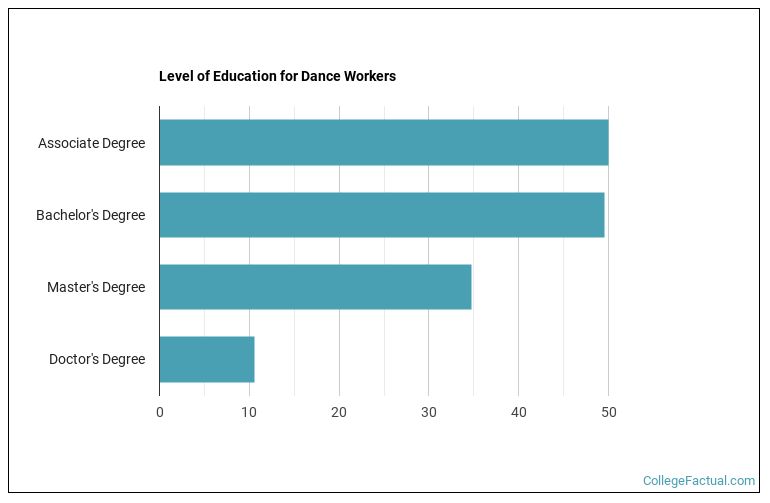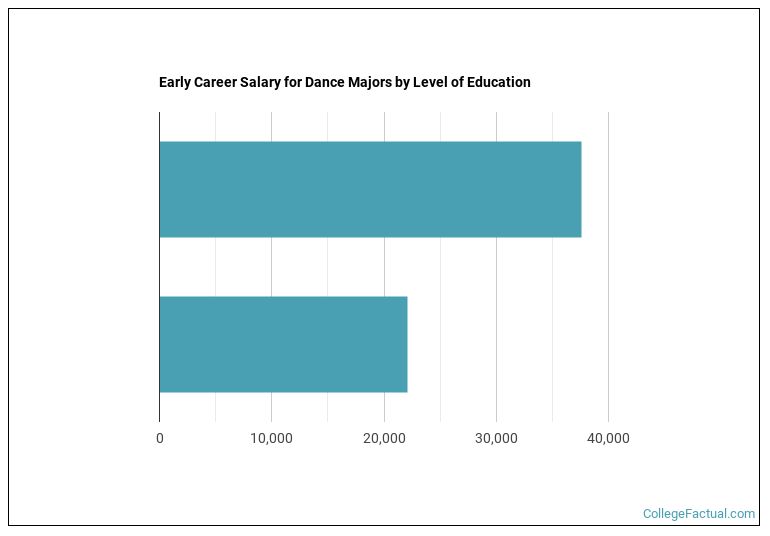 by our College Data Analytics Team
by our College Data Analytics TeamDo you have a passion for dance? Do you envision yourself performing on stage or choreographing routines? A degree in dance may be for you.
Students who major in Dance take classes in the many different styles including jazz, ballet, hip hop, modern, tap, ethnic, and folk dance to continue training in a field they are passionate about. Since a career in dance is extremely competitive, students who pursue this degree to become professional dancers and choreographers have been training for years and have a genuine talent for the art.
Since there are many styles of dance, students often focus on a specific area once entering college. Along with the general Dance major, a popular area of study is Ballet.
Dance was the 158th most popular major in the 2021-2022 school year. Colleges in the United States reported awarding 3,301 degrees in this year alone. This year's Best Dance Schools ranking compares 97 of them to identify the best overall programs in the country. Explore this or one of our many other custom dance rankings further below.
Students who pursue a career in dance have typically been taking classes and been involved in performing from a young age. They have excellent balance and coordination to ensure they can move their bodies quickly and fluidly while performing. Creativity allows dancers and choreographers to create new styles and moves. Other necessary skills include persistence and stamina for long rehearsals, leadership for directing dances, and a passion for the art.
A career in dance is fulltime and can often lead to long hours. Those in companies or involved in performing arts studios may practice during the day and perform at night. Irregular hours are common when working with others and scheduling around other responsibilities. Choreographers at studios may work typical workdays, but spend hours at night or on weekends creating new routines.
Training for a career in dance usually starts at a young age, but some students have begun training in high school. Participation in junior dance companies or summer training programs allows students to gain more experience and improve their skills before pursuing a degree.
Since a career in dance is typically short, some Dance majors pursue a degree in another field for a later career.
New students will need to have completed high school or a GED program and each school will have their own minimum GPA and SAT/ACT test requirements. Once you obtain your degree, additional dance certifications required to pursue a career in this field.
There are many different dance degree levels. You can spend many years getting as high as a in dance to something that takes less time like a . Depending on the dance degree you choose, obtaining your diploma can take anwhere from 1 to 4+ years.
| Degree | Credit Requirements | Typical Program Length |
|---|---|---|
| Associate Degree | 60-70 credits | 2 years |
| Bachelor’s Degree | 120 credits | 4 years |
| Master’s Degree | 50-70 credits | 1-3 years |
| Doctorate | Program required coursework including thesis or dissertation | At least 4 years |
A master's degree is the most common level of education achieved by those in careers related to dance, with approximately 20.2% of workers getting one. People currently working in careers related to dance tend obtained the following education levels.
| Level of Education | Percentage of Workers |
|---|---|
| Master’s Degree | 31.2% |
| Doctoral Degree | 18.0% |
| Bachelor’s Degree | 14.9% |
| High School Diploma | 13.6% |
| Less than a High School Diploma | 7.9% |
See the chart below for the most common degree level workers in dance have received.

The education level required is different depending on the dance career you are seeking.
Dance graduates work for a variety of performing arts studios around the world. Some dance majors have become members of a company, such as the New York City Ballet, while other pursue careers as cruise ship, theme park, or casino performers.
Choreographers find work at dance studios, with professional companies, on Broadway, or at a variety of smaller entertainment companies. Dance and choreography is found in many areas of entertainment, giving dance graduates a variety of job opportunities.
Although the career is growing at an average pace, there is intense competition for positions in performing arts companies or as choreographers. Many people want to perform or choreograph, but there are only a limited number of positions available.
Want a job when you graduate with your dance degree? Dance careers are expected to grow 10.8% between 2016 and 2026.
The following options are some of the most in-demand careers related to dance.
| Occupation Name | Projected Jobs | Expected Growth |
|---|---|---|
| Art, Drama, and Music Professors | 137,200 | 12.0% |
| Dancers | 14,100 | 4.4% |
| Choreographers | 7,100 | 2.9% |
Dance graduates between <nil> reported earning an average of $22,448 in the <nil> timeframe. Earnings can range from as low as $12,039 to as high as $70,806. As you might expect, salaries for dance graduates vary depending on the level of education that was acquired.

Salaries for dance graduates can vary widely by the occupation you choose as well. The following table shows the top highest paying careers dance grads often go into.
| Occupation Name | Median Average Salary |
|---|---|
| Art, Drama, and Music Professors | $82,560 |
| Choreographers | $53,560 |
With over 575 different dance degree programs to choose from, finding the best fit for you can be a challenge. Fortunately you have come to the right place. We have analyzed all of these schools to come up with hundreds of unbiased dance school rankings to help you with this.
Dance is one of 10 different types of Visual & Performing Arts programs to choose from.
| Major | Annual Graduates |
|---|---|
| General Dance | 3,129 |
| Other Dance | 129 |
| Ballet | 43 |
| Related Major | Annual Graduates |
|---|---|
| Fine & Studio Arts | 37,604 |
| Design & Applied Arts | 36,323 |
| Music | 25,860 |
| Film, Video & Photographic Arts | 17,626 |
| Drama & Theater Arts | 17,039 |
Image Credit: By Jazzart Dance Theatre under License More about our data sources and methodologies.